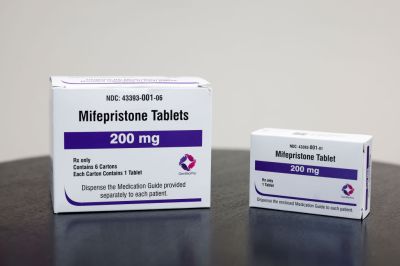An order Friday night from the Supreme Court has kept the United States’ abortion pill status quo in place for now. The two-drug regimen to induce abortion through the first 10 weeks of pregnancy is still approved, and the drugs in question (mifepristone and misoprostol) are accessible for abortions that are still legal under state laws.
What happens when a pregnant woman follows that regimen?
After receiving a prescription from a certified provider, the woman swallows a 200-milligram mifepristone pill. This blocks the hormone progesterone, killing the embryo or fetus (the medical terminology shifts from embryo to fetus after eight weeks gestation) and allowing the second drug, misoprostol, to work more effectively. (Internationally, misoprostol-only abortions are more common, but they are not approved in the U.S. by the FDA.)
Progesterone is a critical hormone for the developing embryo or fetus. “In general, progesterone is pro-gestation,” said Jessica Lee, an assistant professor of obstetrics, gynecology, and reproductive services at the University of Maryland School of Medicine. “It is the hormone that supports an early growing pregnancy and makes the uterus a good environment for pregnancy growth.”
Mifepristone binds to progesterone receptors and prevents the hormone from functioning, thereby killing the fetus. Though some patients may experience very light vaginal bleeding at this stage, mifepristone has almost no side effects, Lee said. But misoprostol does.
By 10 weeks gestational age—the latest in pregnancy the two-drug regimen is approved for, though some clinicians prescribe it past that point—the fetus is a bit longer than an inch, about the size of a small strawberry. Contractions need to be induced to expel the embryo or fetus.
Following the FDA’s regimen, the woman takes 800 micrograms of misoprostol within 24-48 hours of swallowing the mifepristone pill. Doctors could use their discretion to recommend taking the pills as early as eight hours after the mifepristone dose, according to Lee.
While the FDA’s regimen suggests taking the misoprostol pills “buccally”—placing them between the cheek and gum and allowing them to dissolve—taking them vaginally is also common. Both methods allow the drug to bypass the digestive tract and be absorbed more quickly into the bloodstream. From there, the symptoms are like those of a miscarriage.
“We prescribe ibuprofen and they usually have a heat pack with them,” Lee explained, describing the symptoms as “heavier cramping, similar to a very heavy menstrual cycle, and bleeding that can be at times very much like a heavy menstrual cycle as well. And even sometimes a big gush of bleeding, which we do expect, but that shouldn’t be continuous when they pass a majority of the pregnancy.” Some women also experience nausea, vomiting, and diarrhea as side effects. If more serious complications occur or surgery is needed—which happens in 3-5 percent of cases, according to the University of California, San Francisco—the woman may find herself back in a doctor’s office sooner rather than later. Otherwise, the FDA recommends a follow-up with a provider within one to two weeks.
Of the two drugs, mifepristone has historically been more controversial. When it was first approved, prominent conservatives worried it might lead to an increase in abortions. They were only partially right. While drug-induced abortions have become more and more common—accounting for a majority of American abortions by 2020—abortions overall have become more and more rare (albeit with an uptick during the Trump administration).
Lee said she expects that the share of abortions induced by mifepristone and misoprostol has further increased because of a combination of pandemic-era telehealth shifts and the Supreme Court’s 2022 Dobbs decision. Regardless, mifepristone’s legality will continue to be a battleground: After the Supreme Court’s decision on Friday, Alliance for Hippocratic Medicine v. FDA—the federal case brought by a coalition of pro-life groups about whether the FDA failed to follow proper protocol when it approved mifepristone—is back in the 5th Circuit Court of Appeals, with oral arguments set for May 17.





Please note that we at The Dispatch hold ourselves, our work, and our commenters to a higher standard than other places on the internet. We welcome comments that foster genuine debate or discussion—including comments critical of us or our work—but responses that include ad hominem attacks on fellow Dispatch members or are intended to stoke fear and anger may be moderated.
With your membership, you only have the ability to comment on The Morning Dispatch articles. Consider upgrading to join the conversation everywhere.